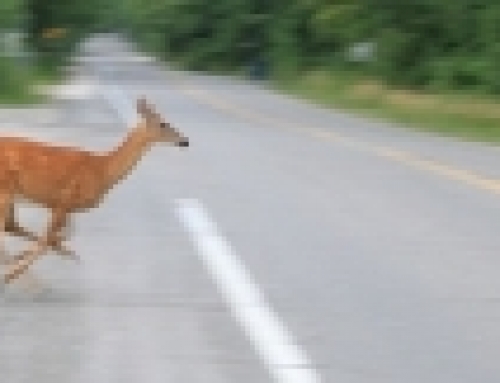 MINIMIZE NIGHT RIDING RISK
MINIMIZE NIGHT RIDING RISK
By Tom “Top Cat” Malia
Motorcycle riding is an inherently dangerous endeavor. To reinforce this assertion, consider the results of some recent government studies. Data from the Governor’s Highway Safety Association and the US Department of Transportation indicates that in the last 10 years, total vehicle fatalities in the US decreased by almost 22%. Unfortunately, in that same period, motorcycle fatalities increased by 51%. On a more local level, motorcycle riders in Illinois comprise about 3% of registered vehicles, yet make up 16% of the fatalities.
I would furthermore suggest that for a number of reasons riding at night can be much more hazardous than riding during daylight hours. As a result, a number of riders, myself included, endeavor to generally avoid riding after dark. However, there are times when either by plan or by unanticipated events, you wind up having to ride in the darkness. It is the intent of this article to outline some things you can/should be doing to minimize your night-riding risk.
The simple fact that it is night means your visibility is dramatically reduced. But for those of us getting up in years, our night vision is even further diminished.
As we age, we require four times as much light to see the same level of detail that we saw in our younger years.
As a result, we simply do not see well at night. And obviously the older automobile drivers around us simply cannot see us as well either.
To enhance your visibility to others you should wear a bright colored riding jacket and helmet. Special tape is now readily available that reflects back over 90% of any light that strikes it instead of scattering the light in other directions. Attaching this to your helmet or machine has a remarkable impact on your visibility to others around you. A three year study in New Zealand found that riders wearing some type of reflective or fluorescent clothing had a 37% lower risk of crash related injury versus those not wearing such clothing. This same study concluded that riders wearing a white helmet, as opposed to a black helmet, experienced a 24% lower risk of injury. This enhanced visibility is also helpful in low-light daytime conditions like fog or rain.
New technology lighting is now available that allows the rider to better see the road ahead and to make a rider more visible to the motorists around them. LED lamps are brighter and whiter in color and provide a superior light pattern over standard incandescent lamps. Compared to the yellow light of a traditional halogen bulb, the LED lamp produces a “Daylight Color Impression” that appears more natural to the user. Such headlamps provide a focused beam of light in front of the motorcycle. The headlamps on BMW’s newest bikes are tied to a gyroscope which senses the direction and extent of the bike’s turns and adjusts the direction of the headlight accordingly so that the light is actually aimed around the turn rather than straight ahead. Aftermarket brake lights and flashers that with one stab of the brake pedal set off a flashing brake light and other conspicuous rear lighting are a good idea. You might also consider fog-lights that illuminate a wider area to the forward lateral quadrants.
But remember that more than half of motorcycle deaths are a result of one-vehicle crashes. The skill and the mental focus of the rider is the most critical factor in minimizing the risk of any riding situation. Do not allow such lighting technology to give you a false sense of security. Active conscious scanning is particularly critical at night and this includes the mirrors and frequent head checks. Do not over-drive your headlights. Time-and space safety-zone maintenance and situational awareness are even more critical at night. You do not want any unknown intruders in your safety zone. You are the one who controls access to your zone so control what you can like lane positioning and following distance. When slowing and stopping in traffic, keep a careful watch to the rear and flash your brake lights as traffic approaches. While sitting at a light or riding in heavy traffic, be sure to focus on possible escape routes as part of your safety-zone maintenance.
A smudged face shield or windshield during the day might only be a minor annoyance. However, they become a serious risk factor after sunset. Be sure everything you look through is clear and scratch-free.
Protecting your eyes with sunglasses is a good idea during the day, but replace them with clear or light-enhancing lenses at night.
Animals, particularly deer, are a more serious risk factor at night. When riding in a wooded area, where animals are likely to be more prevalent, covering controls, adjusting speed and position for maximum space and warning time and consciously and aggressively scanning wider than you may otherwise are some useful strategies to reduce animal-strikes risks. Despite advertising claims regarding deer-whistles, all the scientific studies I have seen indicate that such devices are not at all effective-day or night.
One way to reduce night-riding risk is to ride divided highways whenever possible. These roads are designed to eliminate or minimize cross traffic, provisions have been made to reduce or eliminate animal crossings and virtually all the vehicles around you are traveling in the same direction and at approximately the same speed.
Another night-riding strategy to reduce risk is to consciously seek out another vehicle to follow. Not only do the headlights of the vehicle in front of you lengthen your sight lines and illuminate the roadside verges further ahead, but unexpected brake lights or uncommon maneuvers by this lead vehicle, provide early clues about unusual hazards lurking in the darkness ahead. However as useful as this lead-vehicle-strategy is to provide early warning for some road hazards, it will probably do little to warn of some hazards such as gravel or wet leaves that automobile drivers are typically not very concerned about.
As Greg Zaffke reminded us recently, the proliferation of distracted drivers means it is never a good strategy to stop by the side of the road and anticipate that drivers will see you and avoid a collision. If you must stop, particularly at night, find a place where you can absolutely get well off the road.
In the daylight you can frequently monitor a driver turning left in front of you to make some assessment as to the attentiveness of that individual. Thus you can make some adjustments (slowing, covering your brakes, identifying an escape strategy, etc.) to intelligently compensate for the potential risk. At night, you are unlikely to be able to see such drivers and thus you should proceed through the intersection anticipating the worst.
I am sure we have all seen the statistics that as the evening progresses the percentage of impaired drivers on the road increases. This is particularly true on week-ends. If motorcyclists are frequently not “seen” in daylight by seemingly alert drivers, imagine how your situation deteriorates at night facing alcohol impaired and/or distracted drivers.
Frequently your night riding may be unplanned, meaning something went wrong-you or someone in your group had bike problems, your distance/speed planning was simply wrong, you may have made a wrong turn, you may have been caught in a traffic jam, etc. As a result, your riding day is longer than planned, meaning you are likely both unusually tired and hungry. These factors, potentially combined with frustration over whatever caused the change in your plans, might mean you have a less than ideal mental focus on the task at hand.
While all of the above outlines the risk of night riding, it is also the case that the rewards of motorcycle riding are diminished at night as well. The beautiful scenery you normally ride to enjoy is either not visible at all or greatly reduced. And you would be an idiot to be riding that fun, twisty, country road at the same speed you would be enjoying in daylight.
Remember accidents are caused by an accumulation of risk factors. So if you find yourself in a situation where you think you must ride at night, stop and make a careful assessment as to whether you really must keep riding. Do not give way to the “Press on Regardless” philosophy; consider carefully whether a more prudent course would be to simply find a nearby motel. If you conclude you must keep going, make an intelligent assessment of the added risks and adjust your riding behavior accordingly.





